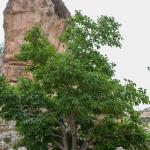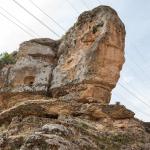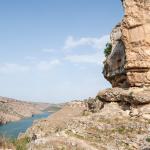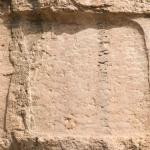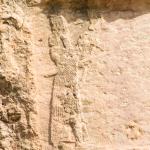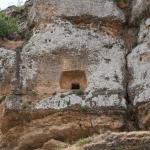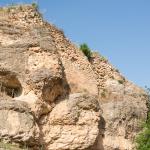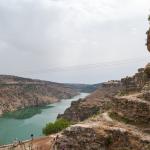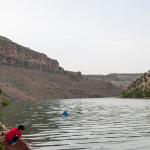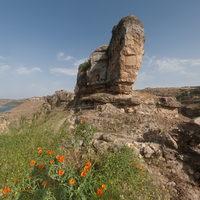Site Profile
The Eğil rock relief is located 50 km north of Diyarbakır, on the southwestern bank of Tigris, at an elevation of 838 m (2750 feet) above sea level. It is found on the eastern outskirts of the small city of Eğil. The relief is carved onto the western face of a formidable natural rock formation overlooking the valley of the Tigris (see the panorama);1 it dates to the Neo-Assyrian period, possibly to the reign of Sargon II. On the northwestern face of the rock formation, there is a rock-cut opening unrelated to the relief.
- 1. Since the completion of the Tigris Dam (Dicle Barajı) in 1997, the water level in this section of Tigris seems to have risen. See the photographs taken before and after the construction of the dam in Bartl 1999–2001, figs. 1 and 2.
Media
Description & Iconography
'Description & Iconography' general sources: Wäfler 1976; Börker-Klähn 1982, 193; Bartl 1999–2001.
Inscriptions
John G. Taylor, British Consul-General for Diyarbakır, visited the site in 1862 and referred to “traces of a long inscription in cuneiform (contained in a niche, 6 feet by 4), which, however, is so defaced as (though easily traceable) to be utterly illegible.”1 Similarly, British Army officer Charles W. Wilson mentions, in his 1895 travel guide, the existence of an “illegible cuneiform inscription,” though it is not clear whether he visited the site himself.2 On the other hand, the Assyriologist L. W. King was at the site in 1904, and his observations are worth quoting here at some length: “[I]t is sometimes impossible to tell without a close examination whether or not it [a panel cut in limestone cliffs] bears an inscription. An example in point is the panel sculptured in the cliff above the village of Egil on the Upper Tigris, to the north of Diarbekr, which has the credit of being inscribed […] And from below it certainly has the look of a weathered cuneiform inscription. But on examining it by means of tackle from above I found that this appearance was due partly to weathering, and partly to the marks of bullets which had pitted the limestone and had knocked away pieces of the surface.”3 In line with King’s observations, neither Peter Bartl's relatively recent reinvestigation of the relief4 nor its close examination by the MMM team in 2015 identified any traces of an inscription.
History
In the second half of the 8th century BC, particularly during the reigns of the Assyrian kings Tiglath-pileser III (744–727 BC) and Sargon II (721–705 BC), there was constant military conflict between Assyria and Urartu. The region of the Upper Tigris where the Eğil rock relief is located was one of the disputed areas between these two major states, and this likely played an important role in the decision to site the relief here. Certainly, Neo-Assyrian rock reliefs often appear in symbolically charged places like river sources, mountain passes, and springs, though not necessarily in easily accessible places. With its formidable position overlooking the Tigris valley and its relatively visible location close to the modern/ancient road, the Eğil rock relief is a remarkable example of Assyrian monuments on the “periphery.”
Early Publications
The earliest modern mention of the Eğil rock relief is found in the travel notes of the British Consul-General for Diyarbakır, John G. Taylor, who visited the site in August 1862 and claimed to have observed a figurative relief as well as an inscription.1 Following him, the British Army officer Charles W. Wilson gave a brief description of the site in his travel guide and affirmed the existence of the inscription, but it is not clear whether he visited the site himself.2 The same goes for the German chemist and traveler/amateur archaeologist Waldemar Belck, whose interest in copying the assumed inscription is indicated in his travel reports, though he apparently later cancelled his visit.3 The Assyriologist L. W. King conducted a close examination of the relief in 1904, arguing against the existence of an inscription.4
Selected Bibliography
Bartl, Peter V. 1999–2001. “Zum Felsrelief von Eğil.” State Archives of Assyria Bulletin 13: 27–37.
Belck, W. 1901. “Forschungsreise in Klein-Asien.” Verhandlungen der Berliner Gesellschaft für Anthropologie, Ethnologie und Urgeschichte, Sitzung vom 21. December 1901. Zeitschrift für Ethnologie 33: 452–522.
Börker-Klähn, Jutta. 1982. Altvorderasiatische Bildstelen und vergleichbare Felsreliefs. Mainz am Rhein: P. von Zabern.
Hrouda, Barthel. 1965. Die Kulturgeschichte des assyrischen Flachbildes. Bonn: Habelt.
King, L. W. 1913. “Studies of Some Rock-Sculptures and Rock-Inscriptions of Western Asia.” Proceedings of the Society of Biblical Archaeology 35: 66–94.
Kreppner, Florian Janoscha. 2002. “Public Space in Nature: The Case of Neo-Assyrian Rock Reliefs.” Altorientalische Forschungen 29: 367–383.
Taylor, J. G. 1865. “Travels in Kurdistan, with Notices of the Sources of the Eastern and Western Tigris, and Ancient Ruins in Their Neighbourhood.” Journal of the Royal Geographical Society of London 35: 21–58.
Wäfler, Markus. 1976. “Das neuassyrische Felsrelief von Eğil.” Archäologischer Anzeiger: 290–305.
Wilson, Charles, ed. 1895. Handbook for Travellers in Asia Minor, Transcaucasia, Persia, etc. London: J. Murray.

























